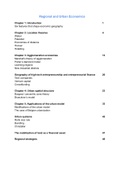Regional and Urban Economics
Chapter 1: Introduction 1
Six features that shape economic geography
Chapter 2: Location theories 4
Weber
Palander
Economies of distance
Hoover
Hotelling
Chapter 3: Agglomeration economies 13
Marshall’s theory of agglomeration
Porter’s diamond model
Learning regions
New Industrial districts
Geography of high tech entrepreneurship and entrepreneurial finance 20
Tech companies
Venture capital
Crowdfunding
Chapter 4: Urban spatial structure 23
Burgess’ concentric zone theory
Brueckner’s model
Chapter 5: Applications of the urban model 33
Modifications of the urban model
The case of Belgian urbanization
Urban systems 42
Rank size rule
Bundling
Christaller
The mobilization of land as a financial asset 47
Regional strategies 49
,H1. Introduction
1.1 Introduction
Geography = interdisciplinary science
a. Physical geography
b. Geographic techniques
c. Human geography
First law of geography: “Everything is related to everything else, but near things are more
related to each other.”
Types of location
a. Absolute: coordinates
b. Relation with its surroundings
i. Physical: accessible by sea, …
ii. Social: cafés near EC HQ full of politicians
iii. Topological: connectivity in network of infrastructure
Usefulness of geography
● Parcel delivery
→ in Antwerpen Zuid distribution center: a lot of deliveries around there
→ install pick up points in center: a lot of failed deliveries in center
→ deliver before and after working hours
● Cholera deaths in Londen: lot of deaths near well, discovered by map
How denser area, how lower delivery costs
“Mr Daisey and the Apple factory”: awareness of economic geography
→ where produced? // why produced there? // how and why transported here?
RUE: what is where and why - and so what?
● What: economic activity
● Where: locations in relation to others
● Why: location theories
● So what: results, complications, organization, …
Region and Urban Economics // Spatial economies // Economic geography // Location theory
1
,1.2 Six features that shape current economic geography
1. Pervasive globalization = increasing econ geographic integration of the world. Movements
across borders of goods, services and capital; labor; knowledge and information; and cultural
goods and activities.
⇒ GDP increases
⇒ no equal distribution of gained wealth
Ex: car manufacturers leaving Detroit
2. Communications revolution
→ connected worldwide
→ quasi costless, instantaneous communication (voice, text and image)
→ cause: computerization (email)
3. Technological improvements in physical transportation
→ larger, faster and more efficient vehicles
→ reduced freight costs: 1500 for 1 container from China to Be
→ planes larger, trains longer, trucks bigger, cargo boats bigger
→ increase of containerization
⇒ more variety of goods
4. Break-up of the Fordist socioeconomic system
→ mass production
→ supported by the Keynesian Welfare State (KWS)
Newly industrialized countries (NIC’s): Hong Kong, Singapore,
Taiwan, Korea ⇒ Brazil, Mexico, Thailand, Malaysia and China
5. Change in the nature of labor markets and work
→ postindustrial, service-based, knowledge economy
→ McJobs: low wage, little required skills or experience
→ creative economy // new economy // cultural economy: highly paid, required skill ex: video
game design
→ disappearing of mixed, low-end jobs ex: bag boy
→ ex: Full Monty
6. Environmental concerns
● Population growth: mostly in urban areas ⇒ urban planning needed
● Global warming: melting of artics ⇒ new trade route for ships
● Clean air: Oosterweelverbinding, low emission zones, ...
● Fresh water: that’s why Golan Heights is so important
● Dependency on fossil fuels: shift to green energy, Azerbaijan shift from oil production to
tourism as main econ activity
● Waste: circular economy
2
, Current developments:
● Brexit ⇒ higher transportation costs, supply chain disruptions
● More online retail
● Covid-19
○ less commuting to other places
○ Post-covid supply chain
■ Disruptions: extra customization
■ Just in time, on demand
○ People want to move to suburbs cus
■ More space, something the lockdown made clear
■ Teleworking more popular
3




